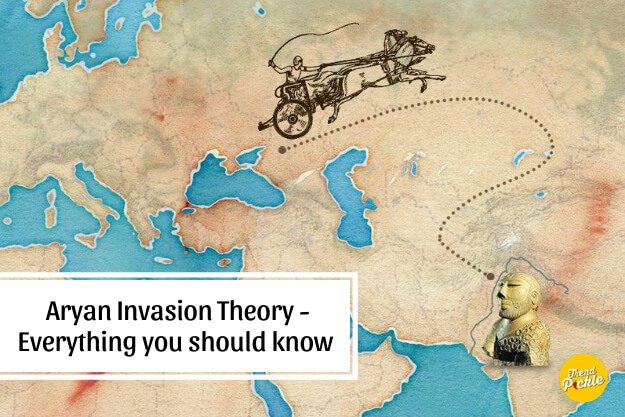Sir Robert Eric Mortimer Wheeler is the person who gave the Aryan invasion theory, he advocated that the demise of Indus valley civilization was due to the invasion of Aryans.
Aryans were ethnolinguistic group which came from central Asia and modern-day Iran, the term Aryan has been used historically to denote the Indo-Iranians, because Arya is the self-designation of the ancient speakers of the Indo-Iranian languages, specifically the Iranian and the Indo-Aryan peoples, collectively known as the Indo-Iranians.
The migration of Aryans is said to be in many waves –
The first wave of migrations are of early Vedic people, it was about in 1500 BC, they came in conflict with dasyus ,dasas etc. , as dasas are also mentioned in ancient Iranian literature, they seem to have been branch of early Aryans. The Rig Veda mention the defeat of sambara by the chief called divodasa of Bharat clan. In this case, the term dasa appears in the name of Divodasa. In all probability, the Dasyus in the Rig Vedas represent original inhabitants of India, and the aryan chief who overpowered them was trasadayus. The Aryans chief were soft toward dasas but very hostile to dasyus. The term dasyuhatya, slaughter of dasus, is repeatedly used in Rig Vedas.

The first wave of Indo Aryans migration went from Hindukush mountains to Gangas in the east. The earliest stratum of Vedic Sanskrit, preserved only in the Rigveda, is assigned to roughly 1500 BC. From the Indus, the Indo-Aryan languages spread from c. 1500 BC to c. 500 BC, over the northern and central parts of the subcontinent, sparing the extreme south. The Indo aryans had established many kingdoms that were very powerful, all over the north India to west Bengal, deep south also.The most powerful of these kingdoms were the post-Rigvedic Kuru (in Kurukshetra and the Delhi area) and their allies the Pañcālas further east, as well as Gandhara and later on, about the time of the Buddha, the kingdom of Kosala and the quickly expanding realm of Magadha. The latter lasted until the 4th century BC, when it was conquered by Chandragupta Maurya and formed the centre of the Mauryan empire.
The Iranian language pushed the Indo-Aryan language of Afghanistan and west-Pakistan. Most Indo-Aryan languages, however, were and still are prominent in the rest of the Indian subcontinent. Today, Indo-Aryan languages are spoken in India, Pakistan, Bangladesh, Nepal, Sri Lanka, Fiji, Suriname and the Maldives.

The second wave of migration are of Iranian
The first Iranians to reach the Black Sea may have been the Cimmerians in the 8th century BCE, although their linguistic affiliation is uncertain. They were followed by the Scythians, whom would dominate the area, at their height, from the Carpathian Mountains in the west, to the eastern-most fringes of Central Asia in the east.
New DNA study challenging the Aryan Invasion theory –

The Indo US team of researchers in September argues that new study found that Aryan invasion never happened.
The evidence comes from the analysis of DNA samples extracted from the skeleton of a woman buried in Rakhigarhi four to five millennia ago.
They claim that Harrapans were the indigenous people and not came from outside, they knew farming, and faming was not new on the land of Harappa.
The authors of the report are Dr Vasant Shinde, vice-chancellor of Deccan College; Niraj Rai, scientist at the Lucknow-based Birbal Sahni Institute of Palaeosciences; Vagheesh M Narasimhan, Nadin Rohland and David Reich from Harvard Medical School; and Nick Patterson from Broad Institute of Massachusetts Institute of Technology (MIT) and Harvard. They worked on the report from 2015 to 2018
However, the report did not rebuke the mix population (of India) theory, they assert that “As the Harappans traded with Mesopotamia, Egypt, Persian Gulf and almost all-over south Asia, there is bound to be movement of people, resulting in mixed genetic history. India had heterogeneous population right from the beginning of settled life and all of them contributed to the development of the region,”
Whether the Aryan migration theory was fact or fictitious it is the topic of debate for archaeologist and historians but we can conclude that we are the mix people, we does not belong to one race, we are mixture of many genetics and race.
Loves History? Test your knowledge by answering these History questions.

